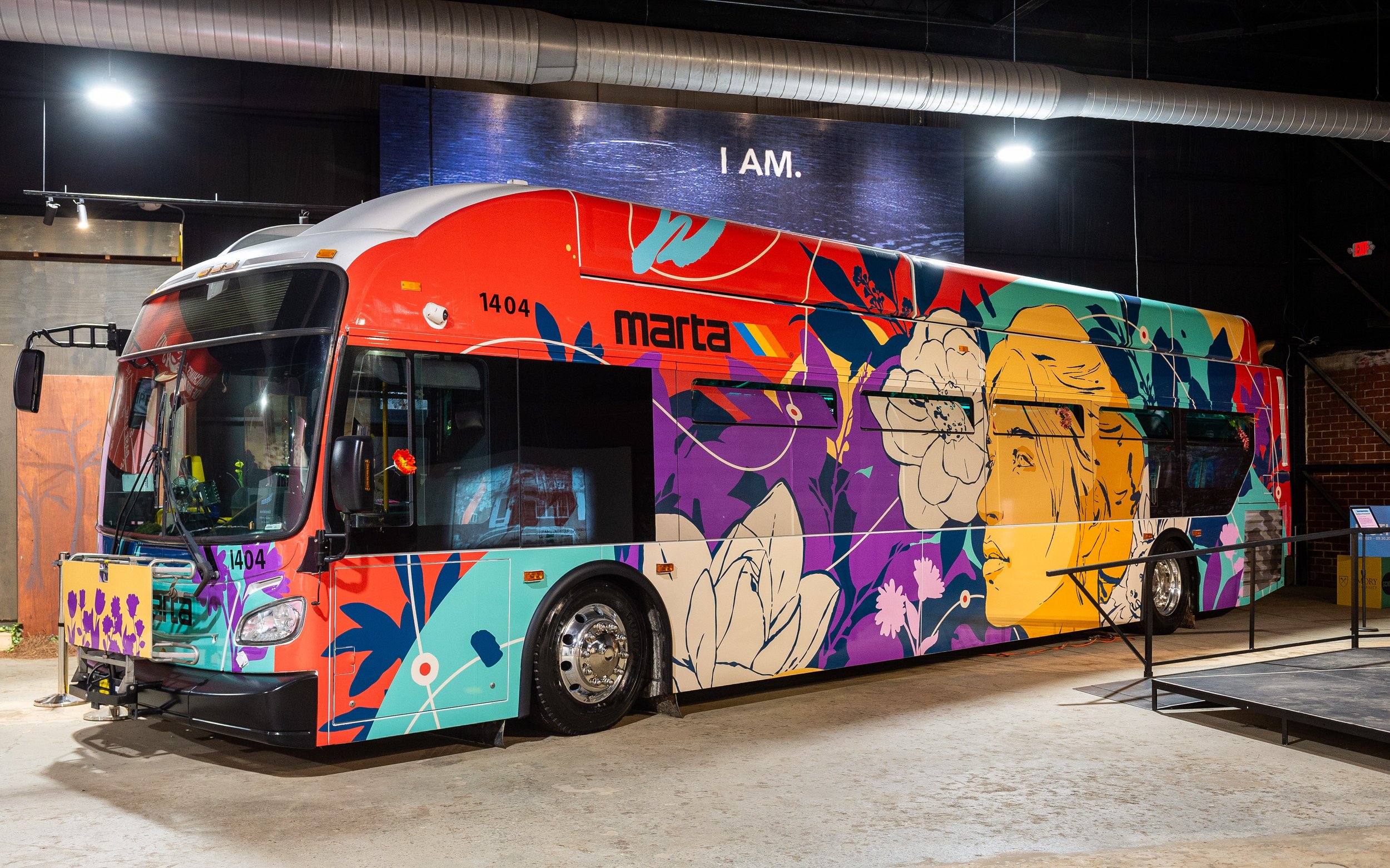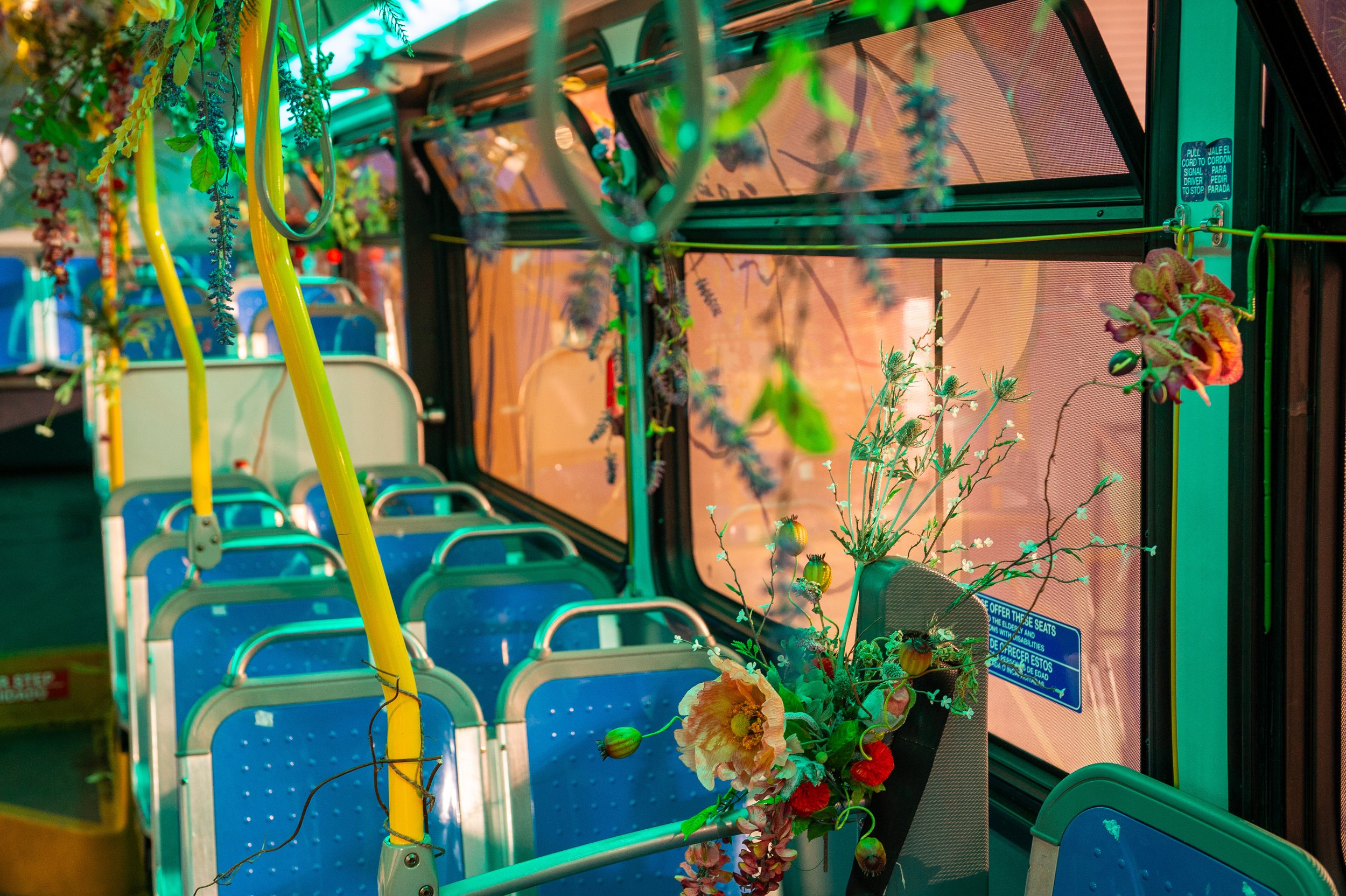Destinations by Sanithna Phansavanh
The re-designed MARTA bus creates a ‘moving’ experience to highlight the role of public transportation in just societies
Sanithna Phansavanh, Destinations, installation view in Science Gallery Atlanta’s JUSTICE (Bita Honarvar, 2023)
For Sanithna Phansavanh, Atlanta-based artist and creator of the Destinations installation at this year’s Science Gallery Atlanta exhibition, justice can be defined as “healthy well-being for all, regardless of situation, and the continuous support that ensures its preservation”. And healthy well-being, it turns out, has a lot to do with public transportation.
Thanks to a partnership between MARTA and the Science Gallery team, Phansavanh was able to use a working MARTA bus as his canvas for his large-scale contribution. He hopes his installation will help raise awareness of the vital role public services play in creating a just and thriving society.
“I started thinking about public transit,” he says. “It affects so many issues that touch on justice: public health, civil rights, economic growth, city planning, and environment. People who have affordable and reliable means to move through their cities are healthier – physically, emotionally, and economically. That seems to me to be a pretty good starting point for justice.”
Science Gallery Atlanta visitors who tour Phansavanh’s redesigned bus are invited into two worlds: one is the bus’s energizing and colorful vinyl-wrapped exterior, and the other is its redesigned and now floral interior, a greenhouse-like space unlike any bus you’ve ever ridden.
“Public transit affects many issues that touch on justice: public health, civil rights, city planning, and the environment.”
These two spaces, interior and exterior, together create a ‘moving’ experience—in both senses of the word. Phansavanh wants gallery goers to think in new ways about public transport, why it matters, and how our passage or movement through cities affects community and societal flourishing.
“For the exterior, I wanted to do something really bright and vibrant,” he says. “But once you get inside, I wanted it to offer a sense of safety, almost an otherworldliness. There’s a transition from outside to interior. It’s a calming space inside.”
Viewers entering the bus find themselves in a blue-green sanctuary thriving with floral life—vines, flowers, and multiple plants, leaving the impression of an arboretum. Phansavanh worked with Lauren Hill of Full Bloom by Lauren to design and install the interior, which includes both live and artificial plants. A transit map above the bus’s windows shows various ‘stops’ on the road to justice, including ‘holistic city planning’ and ‘better-integrated communities.’ Phansavanh sees these stops as structural issues in need of attention and repair. “You have to go through all these stops, these issues, visit and fix them, and the end destination is justice,” he says. “Public transportation helps us move along that path towards the long-term goal.”
A visitor interacts Sanithna Phansavanh’s Destinations during Science Gallery Atlanta’s JUSTICE Community Day (Bita Honarvar, 2023)
“The installation takes viewers from a bright and vibrant outside to a safe and calming, almost otherworldly, inside.”
Outside, the bus’s colorful and mural-like exterior invites viewers to contemplate the intersection of humans and the environment, both built and natural. “The figure on the bus exterior represents all of us,” Phansavanh says, “and is a reminder that we’re not separate from nature. The entire piece tries to instil a sense of harmony.”
Woven throughout the entire installation is a subtle reminder: How we regard public transit in the United States is not how other countries tend to view it. In the US, many of us view public transportation through a class lens—if you can afford a car, you’ll drive it, not take the bus or train. Phansavanh wants to shake up that assumption, or at least to expose it as an assumption. He hopes Destinations reminds people that public transportation is, and should be. for everyone—and that something as simple as choosing to take the bus to work can help move communities to flourish.
Details of the interior of Sanithna Phansavanh, Destinations, installation view in Science Gallery Atlanta’s JUSTICE (Bita Honarvar, 2023)
“Public transportation is, and should be. for everyone”
“Imagine ‘justice’ as a holistically thriving society, a vibrant ecosystem, where public transit, full of established roots and branches, can transport us to areas of progress, allowing us all to grow and bloom together.”
When he’s not redesigning MARTA buses, Phansavanh has shown his work both nationally and internationally. In Atlanta, his art has appeared at the High Museum of Art, along the Atlanta Beltline, as part of the Living Walls conference, and with the City of Atlanta’s Public Arts programs. On an average day, he divides his time between gallery work, public art, and design within art direction and branding. Engaging creatively across multiple fields keeps him challenged and growing, he says.
But at the end of the day, he prefers to keep things less about the artist and more about the dynamic process of creation, which is always in motion, and which invites broader participation in the paired work of imagination and justice. “I’m a guy who makes things,” he says. “That’s about the best way I can describe it.”



